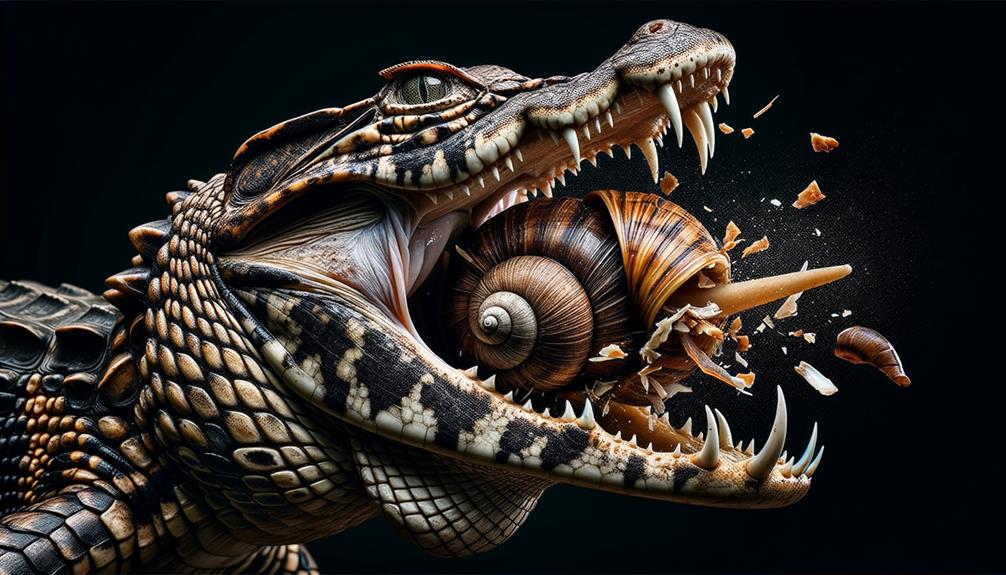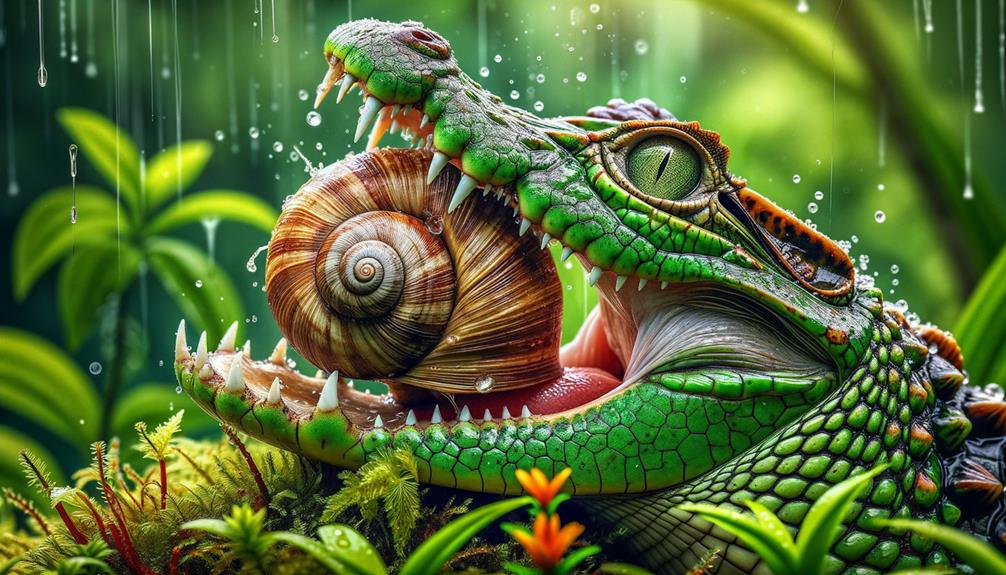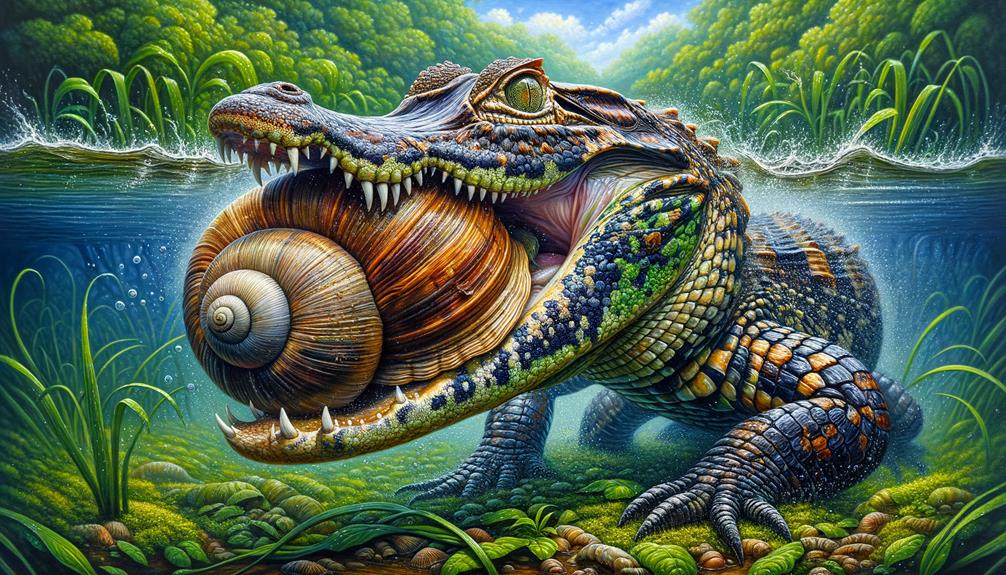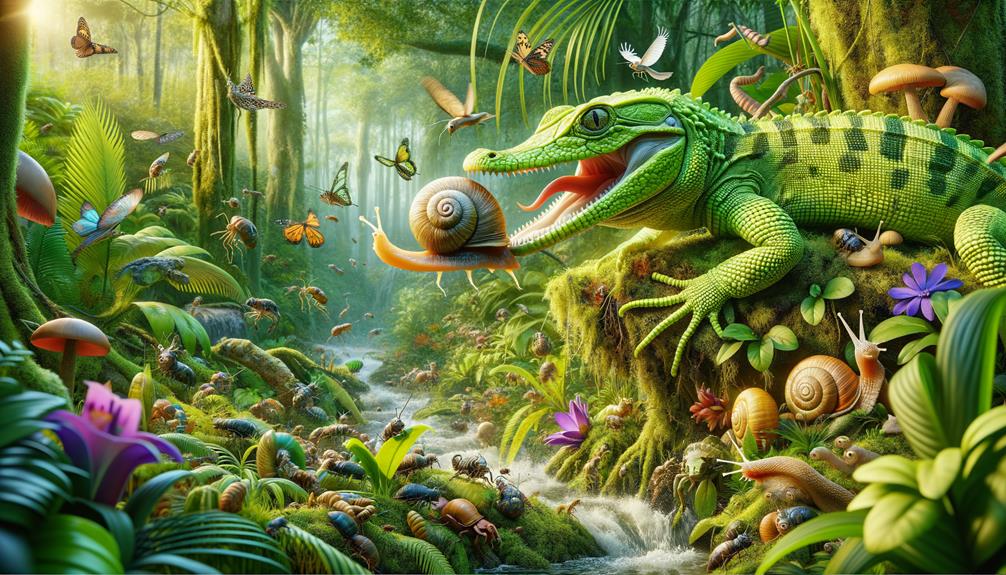The caiman lizard's powerful jaws boast a remarkable 1,300 pounds per square inch bite force, perfectly adapted for crushing even the toughest snail shells. Their short, rounded teeth, resembling flattened molars, allow them to access the soft, nutritious protein inside. This specialization not only enables them to thrive in their aquatic habitats but also positions them as a dominant predator. What fascinates me is how these physical traits are intricately linked to their dietary needs, revealing a complex interplay between form and function. Further exploration is needed to uncover the full extent of how these behaviors impact their ecosystem.
Anatomy of Caiman Lizard Jaws
The caiman lizard's jaws are a remarkable example of evolutionary adaptation, specifically designed to crush the tough shells of snails and other hard-shelled prey. These powerful jaws, equipped with strong muscles and specialized teeth, have evolved to meet a unique dietary need. The teeth are short, rounded, and bead-like, with a flattened, molar-like shape that allows for efficient shell crushing and access to the soft animal protein inside.
What sets these jaws apart is their incredible strength. With a bite force of up to 300 pounds per square inch, the caiman lizard's jaws are among the most powerful in the reptile kingdom. The overbite structure is another clever adaptation, enabling the lizard to securely grip its prey. When I think about the complexity of these jaws, I am struck by their precision and effectiveness.
Bony scales and a third eyelid protect the caiman lizard as it hunts in freshwater clams and other habitats. A reptile vet examining this creature would be amazed by its remarkable jaw anatomy.
Adaptations for Shell Crushing
You can't help but be amazed by the caiman lizard's powerful jaw, which has evolved to crush even the toughest snail shells. This remarkable adaptation showcases the incredible ingenuity of nature. The lizard's short, rounded molar teeth are specifically designed for smashing hard shells, making the crushing process efficient and effective.
The caiman lizard's bite force is truly impressive, reaching an incredible 1,300 pounds per square inch (psi). This immense pressure is not just a random feat, but a carefully developed evolutionary advantage. The lizard's strong, robust jaw muscles and skull structure are adapted to withstand and generate these forces, making it a formidable snail-eating specialist. In its aquatic environment, where snails and freshwater clams are abundant, these adaptations give the caiman lizard a distinct survival edge.
The caiman lizard's jaw is more than just a crushing tool – it's a testament to the power of evolution. Each adaptation, from the jaw's structure to the bite force, highlights how nature fine-tunes its creations for specific ecological niches.
Jaw Strength in Action

Witnessing a caiman lizard's jaw strength in action is a marvel. These exotic animals, native to South America and often found near the Amazon River, possess incredibly strong jaws. It's astonishing to see how effortlessly they crush even the most resilient snail shells.
The force required to break through a snail's hard exterior is immense, yet these lizards accomplish it with minimal effort. Their jaw strength is not just an impressive display; it's a vital tool for survival, honed by evolution. When a caiman lizard clamps down on its prey, the crunch is audible as the shell gives way to their powerful bite.
Each movement is deliberate, every bite a demonstration of their evolutionary design. It's fascinating to observe how these reptiles have adapted to make snail crushing a routine part of their diet. Their jaws are specialized to tackle a variety of food items, making them a standout among the exotic animals of the Amazon.
Their unique blend of brute strength and evolutionary finesse is a testament to their remarkable adaptability.
Dietary Preferences

Observing the caiman lizard's jaw strength leads us to explore its dietary preferences, which are precisely adapted for tackling hard-shelled prey like freshwater clams, crayfish, and snails. As a carnivorous creature, the caiman lizard relies on specialized muscles and teeth to crush the shells of various aquatic animals.
I find it fascinating how these lizards tilt their heads back, positioning their meal near the back of their mouths. With short, rounded molar teeth, they smash the shells to access the soft meat inside. This dietary preference reveals a creature that's not only strong but also incredibly skilled at overcoming the defenses of its prey.
In captivity, maintaining a snail-only diet can be challenging. As a result, a varied diet that includes canned shrimp, superworms, crickets, and even fruit is necessary to meet all nutritional needs. This adaptability in diet highlights the caiman lizard's resilience and versatility.
Here's a glimpse into their dietary world:
| Prey | Diet Component | Adaptation |
|---|---|---|
| Snails | Main | Jaws for crushing shells |
| Crayfish | Main | Powerful muscles |
| Clams | Main | Specialized dentition |
| Superworms | Supplemental | Nutritional needs |
The caiman lizard's diet showcases its unique adaptations and its role as an apex predator in aquatic environments.
Feeding Behavior

The caiman lizard's feeding behavior is a remarkable display of precision and power. Watching a northern caiman lizard in action is an exhilarating experience. These lizards, native to Central and South America's waterways, exhibit a unique and fascinating method of feeding.
When a snail catches its eye, the caiman lizard approaches with deliberate movements, careful not to startle its prey. It's a calculated dance of stealth and strength. With a swift motion, it grabs the snail, positioning it perfectly within its powerful jaws. The jaws clamp down, shattering the snail's shell with a distinct crunch. This isn't just brute force; it's a skillful blend of technique and strength.
For those who keep caiman lizards as exotic pets, witnessing this behavior up close is both thrilling and educational. It highlights the intricate adaptations these lizards have developed to thrive in their natural habitats. The northern caiman lizard's feeding behavior showcases the remarkable traits that have evolved to help these creatures survive and flourish.
Ecological Importance

Understanding the ecological importance of the caiman lizard's snail-crushing jaws reveals how these remarkable creatures play a vital role in maintaining the delicate balance of their native ecosystems. In the lush habitats of South America, these lizards take on the critical role of apex predator, keeping snail populations in check and preventing them from spiraling out of control. This regulation is crucial, especially when invasive snail species threaten to outcompete native species for resources and habitat.
By crushing and consuming these snails, the caiman lizard helps to recycle nutrients, reintroducing essential nutrients back into the ecosystem through their waste. This process enriches the soil and supports plant growth, which in turn sustains other wildlife. The impact of the caiman lizard's dietary habits has a ripple effect, influencing the population dynamics of species that rely on snails for food.
The caiman lizard's ecological importance can be seen in several key areas:
| Impact | Description | Significance |
|---|---|---|
| Snail Population Control | Regulates both native and invasive snail species | Maintains ecosystem balance |
| Nutrient Cycling | Returns essential nutrients to the ecosystem | Supports plant growth and biodiversity |
| Apex Predator Role | Keeps other predator and prey dynamics in check | Maintains diverse and stable ecosystems |
| Habitat Preservation | Protects resources and habitat for native species | Prevents habitat degradation |
Their role highlights the intricate web of life, where every action contributes to the greater harmony of the ecosystem.
Frequently Asked Questions
What Is the Bite Force of a Caiman Lizard?
When I first learned about a caiman lizard's incredible bite force of 1,300 psi, I pictured it crushing a snail's shell with ease. This remarkable strength showcases nature's ingenuity and the lizard's impressive adaptation for survival.
Can Caiman Lizards Eat Mystery Snails?
Caiman lizards can eat mystery snails, and it's a great idea to include them in their diet. Snails are a nutritious food source when gut-loaded and dusted with calcium, which helps support the lizard's overall health. A varied diet is crucial for caiman lizards to thrive, and mystery snails can be a valuable addition to their meal plan.
Are Caiman Lizards Good Pets?
Caiman lizards can make great pets for those willing to put in the effort. They require a spacious, well-maintained habitat and a specific diet. Their size and care needs make them a significant commitment, but a rewarding one for those up for the challenge.
What Are Some Interesting Facts About the Caiman Lizard?
I find caiman lizards fascinating because they're semi-aquatic, reaching lengths of up to five feet, and are incredibly skilled swimmers. Their bony scales and forked tongue help them thrive in dense vegetation. They're a natural marvel!



